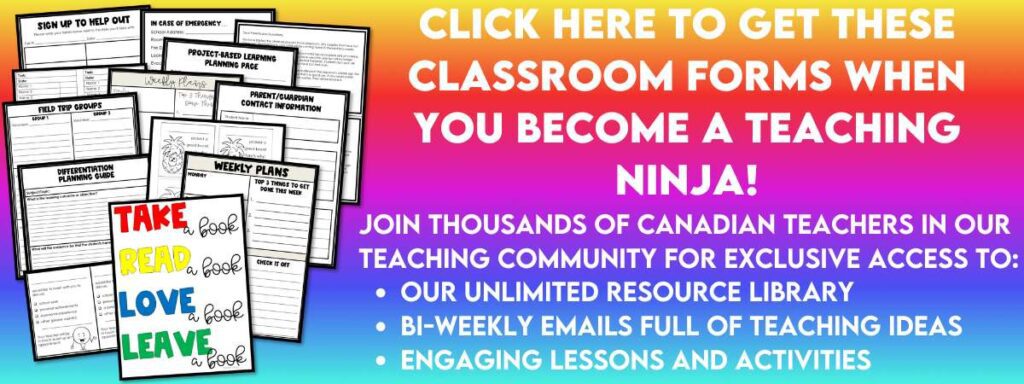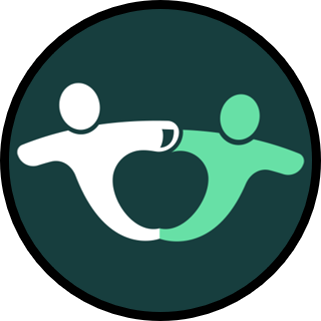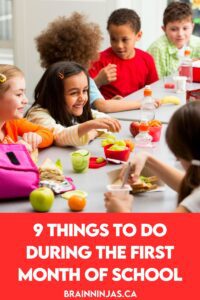
As a student, I never appreciated the first month of school. It always seemed like we didn’t get too deep into the content and spent a lot of time playing games and doing art projects. It wasn’t until I became a teacher that I recognized how much work teachers do during the first month of school. While we created a list with nine of the most important, there really are so many more that could be added.
Create a Welcoming Classroom Environment
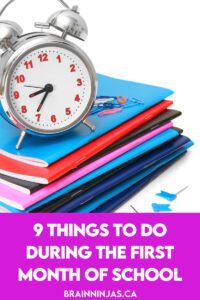
What your students see when they enter your classroom for the first time will set the tone for the year. We are big proponents of not overdecorating as it can be too busy and overstimulate many students. Consider leaving at least one space open for students to add their own work or to add student-created reference materials during the first month of school.
When possible, have different learning materials available and ready to use within the first few days of school. This could be anything from art supplies to math manipulatives. Regardless of what it is, everything should be neatly put away and organized unless you plan on using it right away.
Your classroom environment should be inclusive of all your students (and their families). This might mean considerations for assistive technology, an FM system for better sound, or desk and table placements that make mobility easy. Check that there are no tripping hazards or choke points where traffic will get stuck.
The first day is a busy one, but if you’re looking for what to do on the first day of school, read this post: 10 Things We Do On the First Day of School.
Establish Classroom Expectations in the First Month
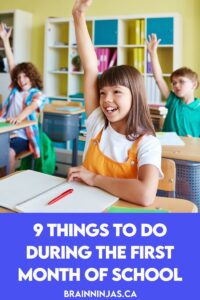
Work with your new students during the first month of school to develop classroom rules and procedures that create a positive and safe learning environment. This could be by developing a set of norms or by simply explaining a few basic rules. You can’t go wrong with asking students to be respectful. That means respecting others by keeping to yourself or not wasting their time. It could mean using resources properly or asking for consent to borrow items not belonging to themselves. Whatever you choose, keep it simple and positive.
One way we work through classroom expectations is to look at expected and unexpected behaviours in the community, the school, and our classroom. We use our Expected and Unexpected Behaviours Unit for Grades 4-6. Find this unit in our TpT Store ($USD) or BN Shop ($CAN). While we use the version designed for grades four through six, we also have a version for grades one through three. Find the Expected and Unexpected Behaviours for Grades 1-3 in our TpT Store ($USD) or our BN Shop ($CAN).
Establish routines for daily tasks, such as lining up, transitioning between activities, and turning in assignments. We use collaborative tasks, which are fun for students but provide an opportunity to establish routines in a natural environment (instead of just listing them all off). If you’re looking for collaborative tasks you can do with your group of students, check out this post, How to Use Collaborative Tasks to Create Classroom Community.
Get to Know Students
The first month of school is the best time to get to know your students through icebreakers and other team-building activities. Learn about their interests and backgrounds. Create opportunities for students to share their experiences.
Our Classroom Community Unit is full of simple activities you can do together during the first month of school. Find it in our TpT Store ($USD) or BN Shop ($CAN).
Sometimes, the fastest way to get to know the needs of your students is to survey parents, guardians, and the students. We use these Learner Profile Surveys and Questionnaires. There are lots of different types of questions to learn about their interests and experiences. It also has a section to collate the results so you can look at ways to accommodate your students. Find the Learner Profile Surveys and Questionnaires in our TpT Store ($USD) or BN Shop ($CAN).
If you are looking for more ways to get to know your students, we’ve written a few different posts.
How to Build Relationships With Students
Conduct Assessments During the First Month
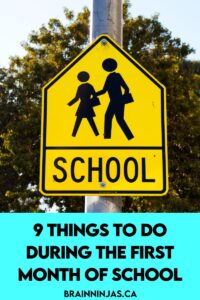
Administer assessments to evaluate academic abilities, including reading and math assessments. These could be formal assessments your school uses or more informal, but observe their work during the first month of school.
If you’re looking for some simple math worksheets to look at general concepts, we have a few free sets.
Math Worksheets Numbers up to 1 000. These work well with students coming into Grade 4. Find them in our TpT Store ($USD) or BN Shop ($CAD).
Math Worksheets Numbers up to 10 000. These work well with students starting Grade 4 or 5, depending on the outcomes for your region. Find them in our TpT Store ($USD) or BN Shop ($CAD).
Math Worksheets Numbers up to 1 000 000. These work well with students starting Grade 5 or 6, depending on the outcomes for your region. Find them in our TpT Store ($USD) or BN Shop ($CAD).
Set Academic Goals
Work with students to set academic goals for the school year. This could include personalized goals or overall class goals. Help students develop strategies for achieving those goals. If you are looking for ways to help students learn to set and achieve reasonable goals, we have a lesson for this in our Life-Long Learning Unit. Find it in our TpT Store ($USD) or BN Shop ($CAN).
If specific goals aren’t going to work for your students quite yet, maybe they just need to choose a power word. Read more in our post How to Create Back to School Power Words.
Establish Home and School Communication
Communicate with parents or guardians with something positive early in the school year. This will help establish a strong partnership and build a rapport before there are any problems.
Decide on a method and teach families where you will put important school information. This could be a website, newsletter, or other form of communication. Be consistent, but also be reasonable about how often you need to communicate. Keep families informed about their child’s progress in school. We have so much information about home and school communication that it really is worthy of its own post. You can read How to Communicate with Parents in a Fast-Paced World. It includes a simple home/school communication log that you can use to get started.
Create Long-Range Plans During the First Month
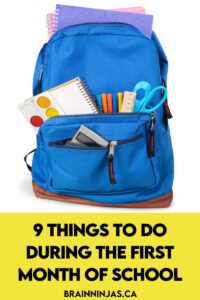
Review the outcomes that are required for your region and grade level. We simply use a calendar to map out a general guide for each of the subject areas. This helps us decide when specific field trips need to be (which is something that usually needs to be booked within the first weeks of school).
Long-range plans usually start with a year plan to outline how the year will unfold. Use it to think about the sequence of your units.
Unit plans have more information about what specifically needs to happen during the unit. You don’t need to have all your unit plans written in the first month, but you should be starting to think through the first units you’ll do for the year and begin to put them together.
As for your day-to-day lesson plans, get yourself a good planner. Planners vary in orientation and style, so you may need to take some time to really figure out what works for you. We wrote a post about different ways to plan: Ways to Plan That Work for You.
If you are looking for some easy-to-use and free planner pages, we’ve got you covered. These are the exact pages we use year after year. We just print them and put them in a binder (so easy and not fancy).
Free planning pages can be found in our Resource Library, along with many other general classroom forms to help you organize your classroom, or we can send them to you when you join our ninja mailing list.
Differentiate Instruction
Differentiating instruction to meet the needs of all students means you need to know your students well enough to know what they need. It means providing support for students who need help and challenging activities for advanced students. It does not mean you must write separate lesson plans for every student.
Being able to differentiate effectively takes time, but it starts by teaching students how to effectively use tools to support themselves. We have an entire post to help you learn about ways you can differentiate without using all your time lesson planning or teaching differently. Read How to Differentiate Your Instruction.
Foster Positive Relationships With Colleagues
Build positive relationships with colleagues by getting to know them. This is especially helpful for grade-level partners. You can collaborate on lesson planning and instruction, share best practices to support student learning, and you might even make a new teacher bestie.
This doesn’t mean you need to be a social butterfly. It just means introducing yourself and getting to know the people you work with. After all, teaching is a lonely profession. It would be nice to have at least one other adult who you can bounce ideas off, vent or share a laugh.
What Else?
Did we forget something? What else should you do during the first month of teaching? Share your ideas with us in the comments below.

